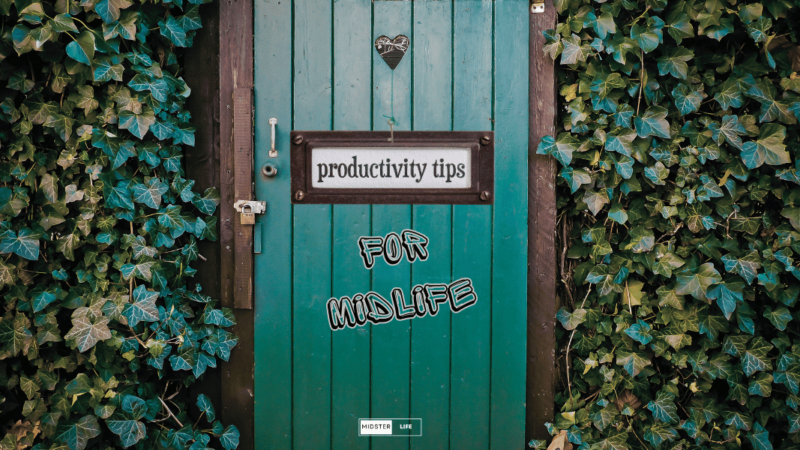Productivity Tips for Midlife: The Ultimate Guide For Over 40s
- Productivity Tips for Midlife: The Ultimate Guide For Over 40s
- The Importance of Productivity for Midlife
- Common Productivity Challenges for the Over-40s
- The Hidden 7: Productivity Assassins
- The Fuel of Midlife Productivity – The Fundamentals
- Midlife Productivity Tips – Strategies to Transform Your 40s
- Bonus Productivity Hack for Your 40s:
- Final Message – Be Consistent
If you’re in your 40s, you might find a multitude of responsibilities continuously competing for your attention. The high-energy zeal and productivity of your younger days may seem elusive as you battle to keep up with the demands of midlife. But fear not! Several effective productivity tips for midlife can help morph this phase of life into a more rewarding and productive period.
Moreover, it’s entirely feasible to stay productive in your 40s, reach your objectives, and maintain a balanced lifestyle. The secret lies in adopting and incorporating fundamental productivity strategies and techniques into your daily routine, thereby making them habitual.
So, let’s embark on this journey together and put your midlife productivity into overdrive!
The Importance of Productivity for Midlife
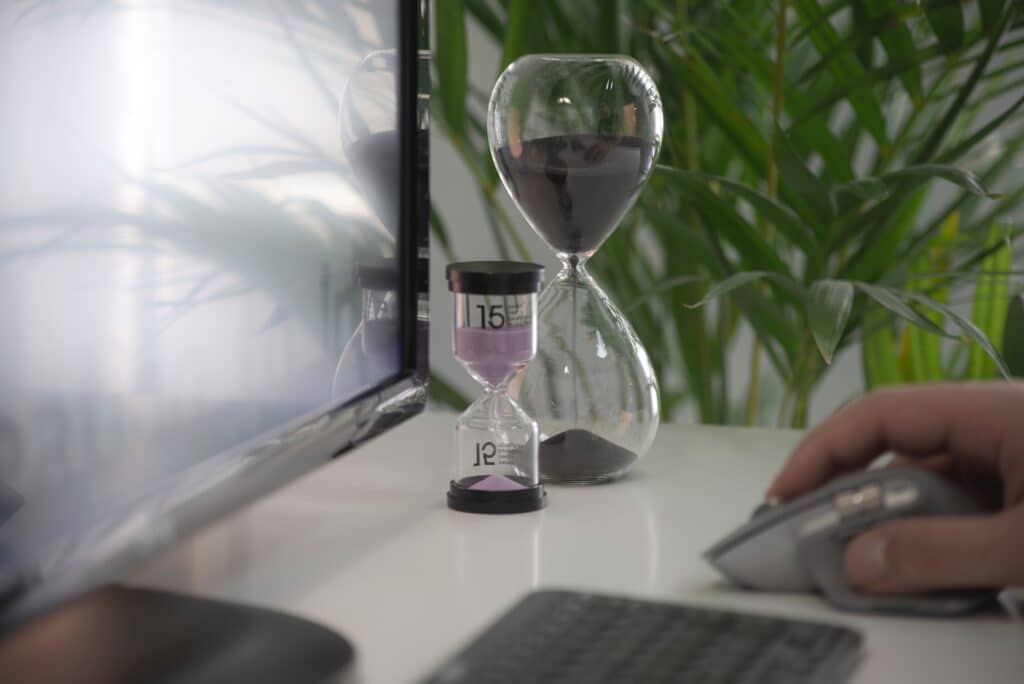
Research indicates that cognitive abilities significantly decline before the age of 50. These declining cognitive abilities can lead to reduced productivity levels. Although, in some cases, experience and job knowledge can outweigh the declines in mental abilities. But in cases where mature adults need to learn new skills, age-related declines in processing speed and learning capacities can impact productivity.
This is important to be aware of as you enter your 40s. Your 40s can be a transitional period with health, energy, and overall work capacity changes. But by staying motivated and productive, you can gain a number of benefits:
Health Benefits
You can reduce stress, maintain mental sharpness, and improve your physical health by staying active and engaged. Regular exercise and a balanced diet are essential to a healthy lifestyle, but remaining productive and focused in life can help further support your physical and mental health.
Career Benefits
Furthermore, productivity is also essential for career advancement during midlife. As you gain more experience and knowledge, developing your skills and taking on new challenges is vital. Staying productive can help you remain competitive in the job market and advance your career.
Additionally, you may also feel like time is slipping away and much remains to accomplish. Productivity becomes increasingly important as you strive to make the most of your time and achieve your goals. So, it is essential to develop strategies to maintain your productivity levels to ensure you can tackle your priorities effectively.
Common Productivity Challenges for the Over-40s

The myriad of responsibilities of midlife can be overwhelming and difficult to juggle, particularly if you feel that your productivity levels have dropped off. You might be struggling with burnout or bad habits that are holding you back from achieving your goals.
Burnout
Burnout is a state of emotional, physical, and mental exhaustion that can result from prolonged stress. As you age, you may be more susceptible to burnout, especially if you are juggling multiple responsibilities simultaneously.
Therefore, it’s essential to take breaks and prioritize self-care to avoid burnout. Make sure you are getting enough sleep, exercise, and healthy food. Take time to do things you enjoy and help you relax, such as reading a book, walking, or playing sports.
Bad habits
Bad habits can be a significant obstacle to productivity. They can include things like procrastination, distraction, and poor time management.
To break bad habits, start by identifying them. Keep a journal and track your behavior throughout the day. Once you have identified your bad habits, put in place strategies to replace them with good ones. By utilizing one or more of the strategies within this post, you can take the first steps toward overcoming bad habits and creating a more productive future.
The Hidden 7: Productivity Assassins

Josh Paulsen’s fantastic productivity course on Udemy identified several killers of productivity that all ages should be aware of:
1). Fear
Our brains don’t distinguish between physical and emotional harm. This is because we are biologically wired for fear to keep us safe. Early human societies needed this fear to protect them from the dangers around them, whether that be animals that could harm them or rival tribes.
Fortunately for us, at least here in the West, we live in relatively benign environments now. Day-to-day threats to our lives are relatively low. However, our minds don’t recognize this, and when we fear that big presentation at work, our mind treats it just the same as running into a lion down by the river.
Overcoming Fear
Take some time to think about your productivity and what is stopping you from moving forward.
Is it a fear of failing? Or a fear of producing work that isn’t good enough?
We often put off tasks that make us uncomfortable or are outside our comfort zone. But by avoiding painful tasks, we are merely kicking the can down the road. It’s still there, nagging your mind, creating anxiety and stress.
So, ask yourself – what am I scared of about getting this task done?
Is the fear real?
What evidence is there to support the fear?
You might be surprised by those answers.
Courage is not the absence of fear. But the triumph over it.
Nelson Mandela
2). Overwhelm
The next common reason behind a lack of productivity in your 40s is feeling overwhelmed. When we get overwhelmed, we freeze, and our brains shut down.
Unfortunately, the tasks remain open, and our brains constantly remind us of that fact! —a sure way to induce anxiety and stress.
And, of course, this typically happens at the worst possible time – usually when we are in bed at night. How many of you have woken up thinking about an outstanding action or task in the middle of the night and then not been able to get back to sleep?
It’s common, but there’s a surefire way to deal with this.
Get all those thoughts out of your head and down onto a piece of paper. Doing this lets you prioritize the list and break the thought loop.
Furthermore, another source of overwhelm is complexity. When tasks feel so big and complex, we feel overwhelmed and freeze.
The key to dealing with complexity is to break the tasks into smaller, more manageable chunks.
How To Break Tasks Down Into Manageable Steps
For example, if you dream of setting up and running your own coffee shop. The task may feel overwhelming, but it won’t feel so daunting if you break it down into smaller chunks.
1). Conduct market research to understand the local coffee industry, competition, and target customer base.
- Make a list of existing coffee shops in the target location.
- Research their offerings, prices, ambiance, and customer reviews.
- Note their strengths, weaknesses, and unique selling points.
2). Determine the ideal location for the coffee shop based on factors like foot traffic, accessibility, and lease/rental options.
- Identify areas with high foot traffic, such as commercial districts, shopping centers, or office complexes.
- Consider proximity to public transportation, parking availability, and ease of access for customers.
- Search for available commercial spaces or properties suitable for a coffee shop.
As you can see, with smaller, actionable steps, you can focus more on your approach and avoid becoming overwhelmed.
3). Lack of Planning
Do you always feel busy without ever achieving what you want to?
If your answer is yes, then there’s a good chance you are getting caught up in other people’s priorities and agendas rather than focussing on what you want to achieve.
By putting in place a plan, you give yourself:
1). Clarity. You have a clear idea of what your priorities are.
2). Commitment. You commit to your priorities, making distractions easier to avoid.
3). Accountability. You have personal accountability to get those priorities completed.
Action tips:
Use your calendar, productivity apps, or to-do lists to create the clarity you need on your priorities and plan when you will take action toward them.
4). Perfectionism

The perfect time doesn’t come, so don’t wait to start. By waiting for the perfect time or the perfect idea, you risk never making any progress, remaining stagnant and trapped somewhere you don’t want to be.
Productivity loves action. Like a rocket firing up into space, the energy required to launch the rocket at take-off far exceeds the amount of energy needed to maintain its momentum.
So get started on that task, that dream, that passion – however small the first step is, take it. Once you get going, you will be surprised by your progress.
5). Multitasking
Research shows that multitasking negatively impacts productivity. Particularly when trying to complete multiple complex tasks simultaneously.
It’s far easier to multitask when carrying out automated, low-complexity tasks like brushing your teeth. But for the more complex tasks we encounter in our daily work lives, multitasking is detrimental to productivity.
A study from the University of California, Irvine, showed that it takes, on average, 23 minutes to regain focus after an interruption. The same study identified that people who are interrupted “experienced a higher workload, more stress, higher frustration, and more time pressure” when trying to complete tasks.
Additionally, many of these interruptions are self-interruptions (time leaks, see below). So, it’s vital to implement strategies that help you block out time for your most important tasks so you can focus 100% on them.
6). Time Leaks
As mentioned above, one of the other big reasons you are not being productive in your 40s is because of time leaks.
When you pick up your phone mid-task because a notification has popped up from a social media app, it can impact your productivity. Other time leaks include surfing the internet, reading emails, or watching Netflix!
Also, we often carry out these activities on breaks, thinking they are a good way for us to relax as we take a few moments away from work. But it’s important to recognize that these types of activities don’t give us the restorative benefits that other activities would. Try taking a break away from your desk and going for a walk outside, or find a quiet spot to carry out a few moments of mindfulness or meditation. Try to ensure your breaks are tech-free to restore energy levels effectively.
Action – if you’re unsure how much time you lose to time leaks, try a productivity tracking app to see where your biggest time leaks are.
7). Mood Management
The final reason impacting your productivity in your 40s is your mood.
Your mood is crucial to your productivity. When you are in a good mood, you will feel unstoppable, but a bad mood can leave you feeling stuck and frustrated.
Because mood is primarily impacted by external factors, e.g., your commute to work, an argument or disagreement with someone, or even the tone of an email, it can sometimes feel like we cannot do anything to change it.
But accepting that you can’t control these external factors is a good place to start. It’s important to remember that you can control how you react to them and how much power you give to them.
Additionally, using movement is a great way to boost your mood. Physical contact with a loved one can increase oxytocin levels and make you feel good. Alternatively, call a friend for a chat. Someone you trust and you know will listen. And don’t forget to use movement to try and turn that mood around. Get outside and go for a walk.
If none of the above suggestions are possible, e.g., if you’re sitting at your desk at work. Try striking a power pose. According to research by Amy Cuddy, power poses can increase testosterone and decrease Cortisol (stress hormone), which can change how you feel significantly and make you feel more powerful.
So try to use your body to make yourself feel positive and engaged, and your productivity will skyrocket.
The Fuel of Midlife Productivity – The Fundamentals
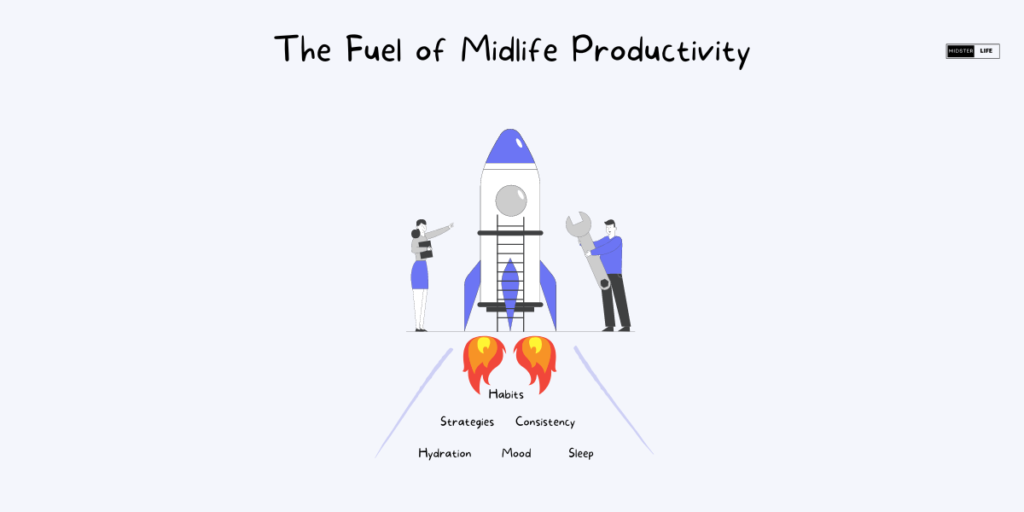
To maximize your productivity in your 40s, you must ensure you have the basic foundations in place. These are even more important in middle age as our bodies and minds begin to slow down.
Sleep
A lack of sleep will impact your productivity. Use sleep trackers to understand better the optimum number of hours you need to feel your best.
Embedding a disciplined time that you go to bed is critical to ensuring you get the rest you need.
Before staying up late to scroll social media or watch that film, ask yourself this simple question:
“Would I get up an hour earlier in the morning to do this?
Josh Paulsen – Life Coach
If the answer is no, then go to bed!”
Hydration
Studies have shown that Dehydration can result “in symptoms that affect productivity, including a loss in concentration, headaches, and tiredness.”
Ensure you drink a glass of water within the first 30 minutes of waking each day.
Try carrying a water bottle with you through the day so you can ensure you are topped up and refreshed.
Mood
As mentioned above, your mood is crucial to your productivity. This can be the difference between you being unstoppable or feeling stuck.
Movement comes before the mood. You can’t wait to be in the mood to do something, so it’s important to act first, and the mood enhancement will come after.
Top tips:
- Listening to inspiring music, motivational speeches, or podcasts.
- Read uplifting and inspiring books.
- Avoid the news!
- Meditate
- Walk outside
- Exercise
You have the control to change how you feel. Focus on what is within your control and not what is outside your control.
Midlife Productivity Tips – Strategies to Transform Your 40s
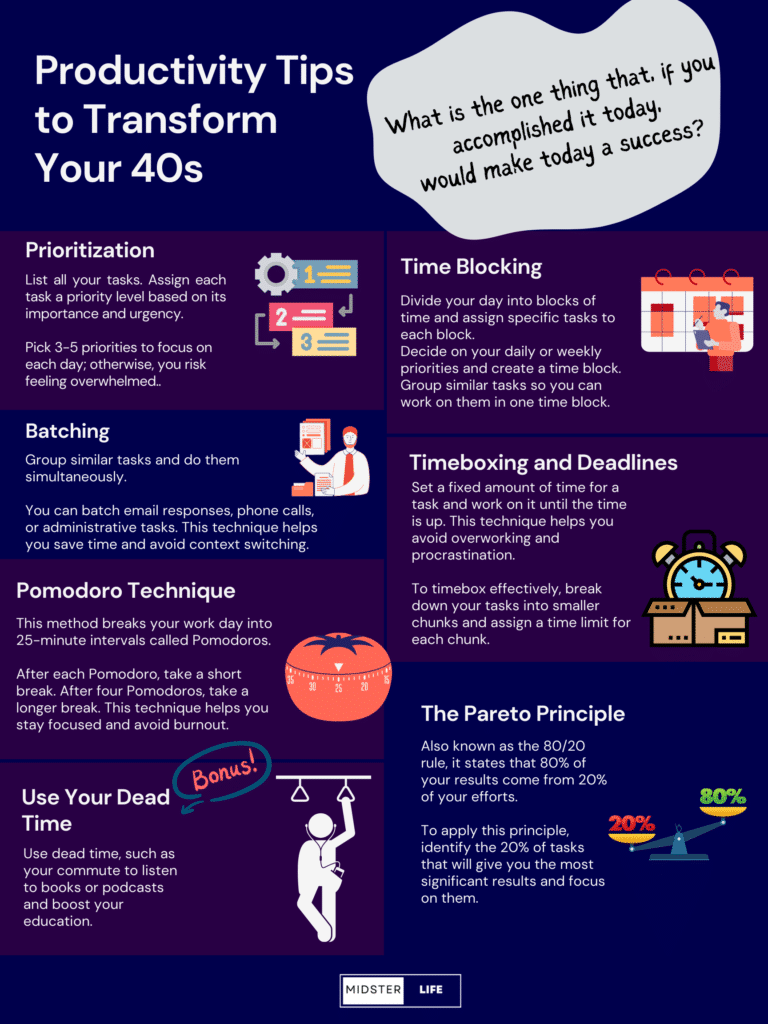
Prioritization
Prioritization is filtering out the most essential tasks from your to-do list and completing them first. To prioritize effectively, start by making a list of all your tasks. Then, assign each task a priority level based on its importance and urgency. You can use a simple system like high, medium, and low or a more complex system like the Eisenhower Matrix.
Try to pick 3-5 priorities to focus on each day; otherwise, you risk feeling overwhelmed. Focus only on those 3-5 and ignore all other priorities for that day. This should limit distractions.
Key Tips:
Ask yourself:
What is the one thing that, if you accomplished it today, would make today a success?
That should be the first thing you start on and your priority.
The first 90 minutes of your day should be laser-focused.
Decide the night before your highest priority task and schedule it into your calendar for first thing.
Time Blocking
Time blocking is a technique where you divide your day into blocks of time and assign specific tasks to each block. This helps you stay focused and avoid distractions. Start by determining your daily or weekly priorities to create a time block. Then, group similar tasks so you can work on them in one time block. Finally, practice scheduling blocks of focus time on your calendar to help you stick to your time-blocked schedule.
Remember, what gets scheduled gets done. Protect your calendar at all costs!
Batching
Batching is a technique where you group similar tasks and work on them within a set time frame or until all are completed. For example, you can batch email responses, phone calls, or administrative tasks. This technique helps you save time and avoid the pitfalls of multitasking, where you lose time switching between tasks. A productivity tool like Asana or Trello can create a batch list.
Timeboxing
Timeboxing is a technique where you set a fixed amount of time for a task and work on it until the time is up. This technique helps you avoid overworking and procrastination. To timebox effectively, break down your tasks into smaller chunks and assign a time limit for each chunk. You can use a timer or a time-tracking app to keep track of your time.
Pomodoro Technique
The Pomodoro Technique is a time management method that breaks your workday into 25-minute intervals called Pomodoros. After each Pomodoro, take a short break. After four Pomodoros, take a longer break. This technique helps you stay focused and avoid burnout. You can use a Pomodoro timer app or a physical timer to keep track of your intervals.
The Pareto Principle
The Pareto Principle, also known as the 80/20 rule, states that 80% of your results come from 20% of your efforts. To apply this principle, identify the 20% of tasks that will give you the most significant results and focus on them. You can use a Pareto chart to visualize your efforts and results.
Bonus Productivity Hack for Your 40s:
Use Your Dead Time
Maximize your dead time. This can include using your commute to listen to books, podcasts, etc., to boost your education, or when waiting for an appointment or to pick up your kids, you can:
- Review calendar and priorities
- Practice gratitude exercises
- Do some deep Breathing exercises.
- Or record ideas and goals
Final Message – Be Consistent
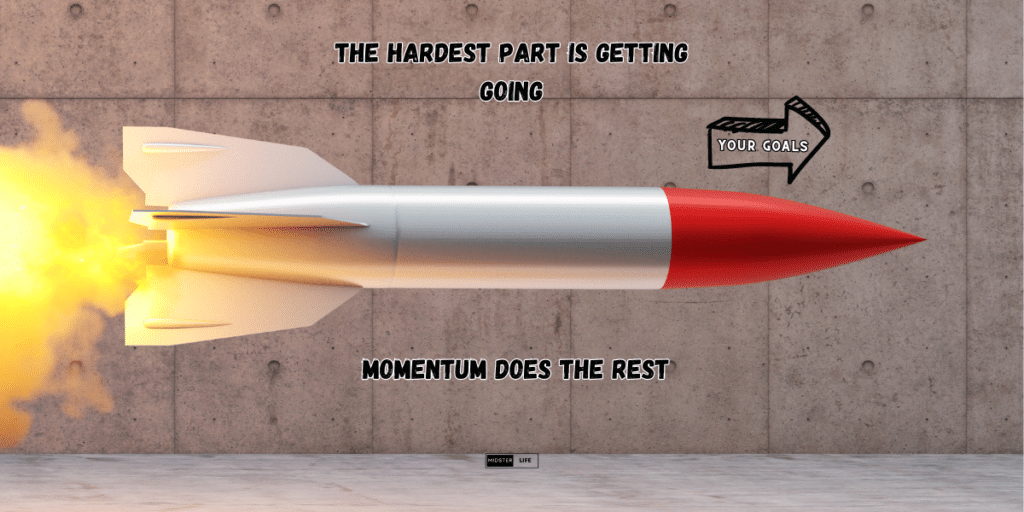
Building positive and repeatable habits is the key to improving productivity in your 40s and beyond. This can be challenging as you overcome years of in-built neural pathways and bad habits.
Start small so you can’t say no.
Midlife Productivity in Action: Build Repeatable Habits
1). Decide on one change you want to make.
2). Choose one behavior you can start today.
3). Decide what will trigger the behavior.
4). Reward yourself for achieving it.
If you want to incorporate more tech-free restorative breaks into your day, it could look like this for you:
“Every day after lunch, I will go for a 15-minute walk.
And as a reward, if I do it all week, I will go to see a movie.”
The commitment is small; you have a repeatable trigger for the behavior and a reward for completing it.
Now it is over to you! If you can implement even one of these strategies into your life, you will have taken the first step toward transforming the productivity of your 40s.
Just get started!

